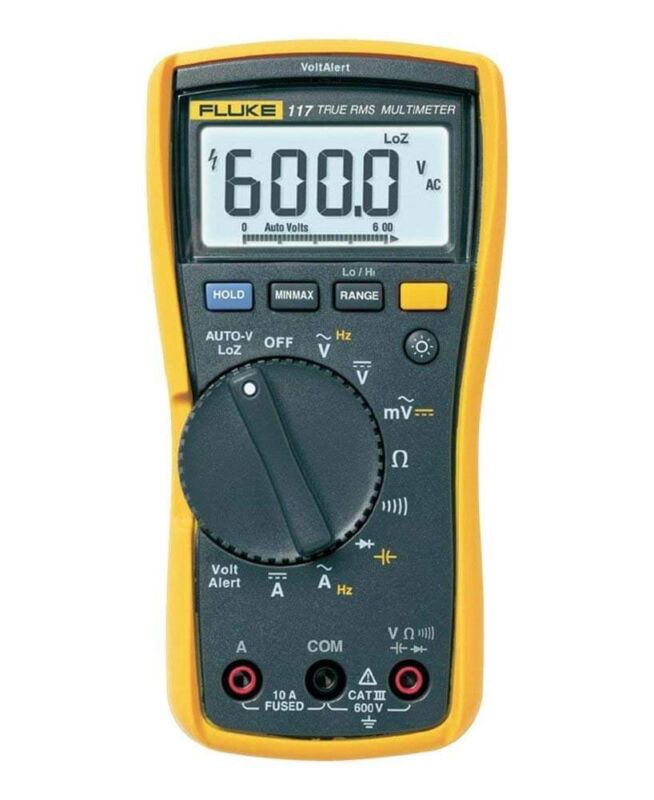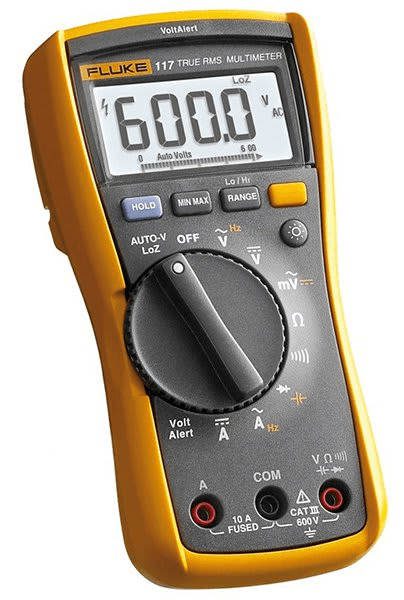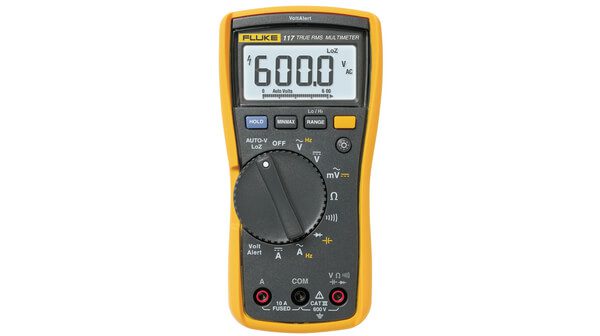
Finding the right multimeter for your particular needs may not always be as simple as it seems. Two popular options in this market consist of the Fluke 116 vs. 117. Both alternatives offer great value with their provisions, but some of the features provided vary between the models. The 117, for instance, comes with an automatic shutdown function that’s designed to save battery life.

There are a myriad of multimeters available in the market, and though they’re generally designed to perform similar tasks – different models will have varying capabilities. Fluke has long been at the forefront of quality multimeters.
Fluke 116 vs. 117 alternatives are two popular options in this market that surpass the majority of their competition in terms of quality. Both come in a digital format that makes the recording and reading of measurements a simple task that can be quickly accomplished.
These devices also come with black, and red test leads for the measurement of elements such as resistance and capacitance, to name a few.
Differences between Fluke 116 vs. 117 – How do they compare?
| Model | Fluke 116 | Fluke 117 |
| Non-contact voltage detection | No | Yes |
| Automatic modes | Switch off function after 15 min | Extended backlight presence |
| Inbuilt Thermometer | Yes | No |
| True RMS | No | Yes |
| Check price | Check price |
Fluke 116 vs. 117: What is the difference?
Safety and Design
One of the major features of all Fluke multimeters is their reliability in terms of quality and design. Both the Fluke 117 and 116 weigh just above a pound, making them impressively light to carry. This can be a great aspect for users who may have to keep the tool around them all day.
They also come equipped with a rubber holster that is designed to absorb any potentially damaging shock the device might experience upon sudden impact. Its ergonomic design makes it suitable for comfortable one-handed use, which is a great feature when working with constricted spaces.
The devices have satisfied the CAT III 600V safety ratings, making them applicable for a variety of projects around one’s residence. Both products also come with a three-year warranty, guaranteeing their potential longevity in the process. They also come with NIST calibration certification to further support the prowess of their capabilities.
Range and Measurement Features
The Fluke 116 and 117 are designed to address a variety of elements, depending on the job involved. Both devices are capable of measuring capacitance, resistance (40 MΩ), voltage (AC/DC), frequency, and continuity. The maximum voltage for each of the alternatives stands at 600V.
There are a number of areas in this sector, however, where the two products differ from one another. The Fluke 116 comes with an inbuilt thermometer, for example, that also allows for the measurement of temperature. This additional range allows the user to deal with levels reaching a maximum of 400°C.
The Fluke 117, on the other hand, features VoltAlert technology that provides for non-contact voltage detection. This means that you don’t need test leads when measuring voltage with this model.
All you have to do is let the tool hover over the area you would like to examine, and its top-notch detection software will do the rest. This feature acts as a great safety enhancement provision for users.
Automatic Features
Both the Fluke 116 and 117 come with automatic features that are designed to ease the simplicity of a couple of functions. The 116, for instance, comes with an automatic-off button that shuts it down when it has been continually idle for a period of 15 minutes.
This is a great means of saving the battery, as forgetting to turn off a device is a weakness that many of us suffer from when working on a project requiring multiple tools. This auto feature resets the countdown every time a button or dial on the tool is used.
You can also deactivate this feature by pressing the yellow button for an extended period when powering on the device.
The Fluke 117, on the other hand, comes with a backlight that can be turned on via a button on the device, and it automatically turns off after about 40 seconds. This feature is also designed to save on battery life.
However, there may be some instances where you’ll be working in dimly lit surroundings for an extended period. In such cases, if you’d like to deactivate the automatic 40-second shutdown, you can simply press the light button for an extended period when powering on the device.
Power Source
The Fluke 116 and 117 both feature a corded electric power source that charges the device when connected. Using the tool while it’s still plugged in might be possible, but it will definitely hinder your overall movements due to the cord.
This might make it harder for you to access some hard-to-reach areas. The 9V alkaline batteries provided with both tools ensure that you can use them for an extended period before you have to juice it up again. Both the Fluke 116 and 117 boast an extended battery life of about 400 hours.
This means that you can go about your day carrying out the various tasks related to your work without worrying about your multimeter suddenly running out of power. Its longevity also means that you don’t have to charge the tool on a daily basis, which in most cases, can reduce the peak performance levels of a battery over time.
Readings and Assistance
Another major element that should be taken into consideration is the kind of readings available with a particular option. As mentioned earlier, different multimeters may be designed to excel at particular functions more than others.
The Fluke 116 and 117, for example, have been touted as great alternatives for professionals working with a lot of electrical systems. This is due to a number of features that come with the products, including the integration of True RMS technology.
The addition of this component enhances the accuracy levels enjoyed by the devices, especially when dealing with non-linear loads. The readings procured thus can be accurate by up to 0.5%, which can be crucial when working on projects such as HVAC systems.
This feature is especially crucial when working in an environment featuring a variety of unfavorable elements, such as noisy surroundings.
Display and Visual Assistance
Most people make the mistake of assuming that every digital device automatically comes with satisfactory display settings that will simplify issues for the reader. However, just because you can read the data displayed in a digital format doesn’t mean that you will be able to work out all the information provided clearly.
To enhance this area, both the 116 and 117 feature a backlight that helps when working around darker regions. It should be noted, however, that the 117 doesn’t detect low light automatically, and thus will have to be manually turned on by the user when needed. However, it also comes with a feature that allows the user to ensure it stays on throughout the tool’s use when dealing with extended periods.
Flexibility
The flexibility of a particular device deals with the various options on offer when it comes to issues such as range and other related alternatives. It has already been noted that both the Fluke 116 and 117 offer a similar range of measurements in this sector.
This collection is also enhanced by the variety available from the categories on offer. Voltage, for instance, entails both DC and AC elements. The 116’s thermal measuring capabilities can also be displayed in both Celsius (°C) and Fahrenheit (°F) formats. This can be a useful feature when dealing with a variety of jobs, as you never know what the specifications of a certain project might entail.
Fluke 116 vs. 117 Review: Pros and Cons
Fluke 116

Fluke 116 is a great multimeter alternative for individuals looking to enter into professions such as HVAC maintenance and repairs.
The multimeter comes at an attractive price in the market, ensuring you don’t have to part ways with a significant sum to enjoy such quality provisions. Its digital display comes with an automatic LED light that is activated when the tool is operating under dimly lit environments.
It also features large numbers on the screen to enhance the identification of the readings provided. This tool is a great device to use for extended periods, as its lightweight components allow for comfortable one-handed use.
One of the standout features of the Fluke 116 is that it comes with an inbuilt thermometer, allowing you to measure temperatures between -40°C – 400°C without the need for another tool.
This section also includes a probe that is utilized when contact is required for better measurement results. It should be noted that in cases where a liquid is involved, the potential corrosiveness of the component should be effectively noted to prevent you from potentially damaging the probe when making contact.
It also features a data capture mode, which records the last values indicated with your readings until you clear it with a new one.
Pros
- Inbuilt thermometer
- Data capture mode
- Auto-off feature that activates after 15 min
- CAT III 600V safety ratings
Cons
- It has a limited range when it comes to temperature measurement, with its threshold standing at 400°C
- There have been a few complaints about the accuracy levels of some of the thermal readings
View price on Amazon
Fluke 117

Fluke 117 is a great multimeter for electricians and professionals working in similar fields. One of the standout features includes its non-contact voltage detection capabilities, which enhance the safety levels enjoyed by the user.
This feature allows you to note any voltage in an area by simply letting the device hover over the spot concerned. Fluke’s model transmits this capability through its dependable AlertVolt system. The device comes with black, and red test leads for the measurement of other elements as well.
It also features CAT III 600V safety ratings, as well as NIST certification, that guarantee the highest standards are implemented during the production process.
Another useful feature of this model is its extended backlight mode. Most backlights are designed to stay on for certain minimal periods (such as 40 seconds with the Fluke 117) after which they shut off automatically.
Some situations, however, require this light to remain on for an extended period. Having to press the button every 40 seconds can be an annoying task when working with dim lighting. The 117 alternative comes with a feature that allows you to keep the backlight on throughout the entire process – until you turn the device off again.
This can be achieved by simply pressing the light button for an extended period when turning the power on to your device.
Pros
- Non-contact voltage detection
- You can extend the active period of its backlight
- Reliable warranty
- Long battery life
Cons
- Cannot measure temperature
- The display suffers contrast issues from certain angles
- The backlight doesn’t turn on automatically
View price on Amazon
The Final Verdict
In conclusion, the 117 arguably represents the best option when looking at both alternatives, unless you’re in need of a thermo-capable alternative. The implication of a non-contact voltage detection system not only enhances your safety but can greatly speed up the pace of the process as well. You can also integrate the measuring of temperatures through the integration of a thermo-coupling accessory.
FAQs
Can you measure temperature with Fluke 117?
No. Fluke 117 doesn’t come with an inbuilt thermometer. For that option, you will need to get the 116 alternative.
What does non-contact voltage detection mean?
This is a feature that lets you identify the presence of current without coming into direct contact with the area involved.
How long is the warranty on offer for Fluke 116 and 117?
Both products come with a warranty of three years.
How do I calibrate my multimeter?
Calibration can take place in a few easy steps. The instructions can be found on the owner’s manual, together with the specific values entailed.
Can I measure the temperatures of different elements with my Fluke 116?
Yes, you can. The probe is capable of measuring different elements, including solids and liquids.
